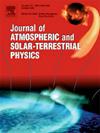季节辐照度模式的增强估计:适应时间同步平均法
IF 1.9
4区 地球科学
Q3 GEOCHEMISTRY & GEOPHYSICS
Journal of Atmospheric and Solar-Terrestrial Physics
Pub Date : 2025-09-16
DOI:10.1016/j.jastp.2025.106620
引用次数: 0
摘要
在辐照度数据中准确地从背景噪声中分离循环模式对于各种应用至关重要,包括监测光伏板。然而,季节性,如辐照度波形中的幅度调制,对时间同步平均(TSA)和倒谱编辑(CE)等现有方法提出了重大挑战。这些方法难以有效地消除季节性对估计周期型的影响。这项工作提出了一种称为自适应时间同步平均(ATSA)的新方法来解决这些限制。新方法的灵感来自于在旋转机械的机械信号中使用的循环静止工具的应用。ATSA采用三步方法:信号归一化以减轻季节性,使用归一化数据进行TSA估计,以及自适应滤波进行信号重建。我们的分析表明,在从辐照数据中的随机噪声成分中分离循环模式方面,ATSA优于TSA和CE。本文章由计算机程序翻译,如有差异,请以英文原文为准。
Enhanced estimation of seasonal irradiance patterns: The adapted time synchronous average method
Accurately separating the cyclic pattern from background noise in irradiance data is critical for various applications, including monitoring photovoltaic panels. However, seasonality, evident as amplitude modulation in the irradiance waveform, poses a significant challenge to existing methods like Time Synchronous Averaging (TSA) and Cepstral Editing (CE). These methods struggle to effectively remove the influence of seasonality on the estimated cyclic pattern. This work proposes a novel method called the Adapted Time Synchronous Average (ATSA) to address these limitations. The new approach is inspired by the application of cyclostationary tools used in mechanical signals of rotating machinery. ATSA employs a three-step approach: signal normalization to mitigate seasonality, TSA estimation using the normalized data, and adaptive filtering for signal reconstruction. Our analysis demonstrates that ATSA outperforms TSA and CE in separating the cyclic pattern from the stochastic noise component in irradiance data.
求助全文
通过发布文献求助,成功后即可免费获取论文全文。
去求助
来源期刊

Journal of Atmospheric and Solar-Terrestrial Physics
地学-地球化学与地球物理
CiteScore
4.10
自引率
5.30%
发文量
95
审稿时长
6 months
期刊介绍:
The Journal of Atmospheric and Solar-Terrestrial Physics (JASTP) is an international journal concerned with the inter-disciplinary science of the Earth''s atmospheric and space environment, especially the highly varied and highly variable physical phenomena that occur in this natural laboratory and the processes that couple them.
The journal covers the physical processes operating in the troposphere, stratosphere, mesosphere, thermosphere, ionosphere, magnetosphere, the Sun, interplanetary medium, and heliosphere. Phenomena occurring in other "spheres", solar influences on climate, and supporting laboratory measurements are also considered. The journal deals especially with the coupling between the different regions.
Solar flares, coronal mass ejections, and other energetic events on the Sun create interesting and important perturbations in the near-Earth space environment. The physics of such "space weather" is central to the Journal of Atmospheric and Solar-Terrestrial Physics and the journal welcomes papers that lead in the direction of a predictive understanding of the coupled system. Regarding the upper atmosphere, the subjects of aeronomy, geomagnetism and geoelectricity, auroral phenomena, radio wave propagation, and plasma instabilities, are examples within the broad field of solar-terrestrial physics which emphasise the energy exchange between the solar wind, the magnetospheric and ionospheric plasmas, and the neutral gas. In the lower atmosphere, topics covered range from mesoscale to global scale dynamics, to atmospheric electricity, lightning and its effects, and to anthropogenic changes.
 求助内容:
求助内容: 应助结果提醒方式:
应助结果提醒方式:


